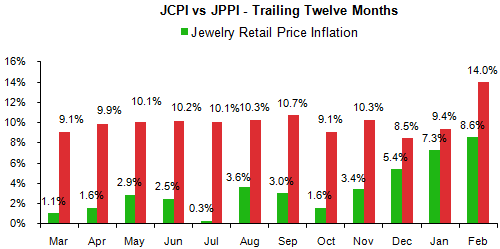IDEX Online Research: Retail Jewelry Prices Surge in February
March 30, 11
(IDEX Online News) - After languishing for most of 2010, retail jewelry prices in the U.S. market began to rise in November, culminating in an inflation surge of 8.6% in February 2011. This is the largest monthly retail jewelry price inflation level in more than two years and multiples above the average retail jewelry price inflation rate during 2010 of 2.1%.
The full analysis is available to IDEX Online Research subscribers and IDEX Online members here.
The disparity between wholesale jewelry price inflation and retail jewelry price inflation continued to abate in February. With stronger demand, retail jewelers are willing to mark their store prices higher in an attempt to recoup some of the margin erosion that they experienced over the past couple of years.
What is pushing prices higher? Most of the price inflation in 2009 and 2010 came from precious metals – specifically gold. This year, both precious metals prices and polished diamond prices have risen sharply. Further, diamond prices continue to rise, fueled by higher rough diamond prices and stronger demand from consumers. Currency swings have not been a major contributor to inflation in recent months. As a result of higher commodities costs, retail jewelers have had no choice but to increase the price of their merchandise.
The table below summarizes inflation in the U.S. jewelry industry for the month of February 2011.
| Inflation Component | February 2011 vs January 2011 | February 2011 vs February 2010 |
| Retail – All Jewelry & Watches | +1.0% | +8.6% |
| Retail Jewelry | +1.1% | +10.1% |
| Retail Watches | +0.5% | (0.4%) |
| Supplier – All Jewelry & Watches | +3.3% | +14.0% |
| Supplier – Precious Metal Jewelry | +4.6% | +16.5% |
| Supplier – Watches | 0.0% | +0.1% |
Inflation Gap Between Retail & Supplier Prices Narrows
Retail jewelers have been absorbing higher supplier prices for about two years. However, in November 2010, retail jewelers began to push their prices higher. With stronger-than-expected demand in the 2010 holiday selling season of November-December, retailers felt that consumers would not balk at higher prices. As it turns out, they were correct: for most items, consumers did not blink at the higher prices.
The graph below summarizes the disparity between retail and supplier price inflation for most of 2010. Beginning in November, retail prices (green bars) began to rise. By January 2011, retail price inflation was closing in on supplier price inflation. However, in February, supplier (wholesale) prices leaped, far exceeding jewelry retail price inflation.

Source: BLS
Outlook: Inflation Is Back
As the global economy begins to heat up, there will be increasing demand for “hard assets” – specifically commodities including gold, platinum, silver, palladium and diamonds. All of those commodities are major cost components of jewelry.
In the U.S. market, Federal Reserve officials are watching inflation closely. On one hand, there is pressure to provide a boost for economic growth; but that will inevitably lead to rapid inflation. On the other hand, most of the Fed’s governors have opted to let the economy grow at a slower pace in hopes of keeping inflation low. The problem is this: 2011’s inflation numbers, both for the jewelry industry and other industries, indicate that inflation is real. In short, it appears that merchants in all sectors are trying to recoup margins – hopefully, not at the wrong time, just as the economy is getting on solid footing.
The full analysis of the jewelry prices at the producer level and the consumer level in February is available to IDEX Online Research subscribers and IDEX Online members here. Click here for more information on how to subscribe or become a member.